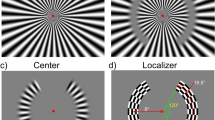Abstract.
The cortical areas underlying successive spatial-frequency discrimination were explored using functional magnetic resonance imaging (fMRI). In a steady-state, block-design paradigm, 12 subjects viewed a single fixation cross during a rest period, followed by an activation period consisting of the presentation of horizontal (distractors) and vertical (targets) sinewave gratings. Two tasks were performed: in the control task, subjects pressed a button after the second vertical grating was presented within each trial; in the discrimination task, subjects decided which target grating had the higher spatial frequency. Post-processing consisted of off-line image registration to correct for head motion, spatial and temporal smoothing, and cross-correlation between each voxel time course and a phase-shifted stimulus time profile. The results indicate that striate, extrastriate, parietal, and prefrontal areas show significant BOLD (blood oxygen level dependent) effects during both discrimination and control tasks, with consistently higher activity levels in the discrimination task.
Similar content being viewed by others
Author information
Authors and Affiliations
Additional information
Electronic Publication
Rights and permissions
About this article
Cite this article
Greenlee, M., Magnussen, S. & Reinvang, I. Brain regions involved in spatial frequency discrimination: evidence from fMRI. Exp Brain Res 132, 399–403 (2000). https://doi.org/10.1007/s002210000385
Received:
Accepted:
Published:
Issue Date:
DOI: https://doi.org/10.1007/s002210000385



